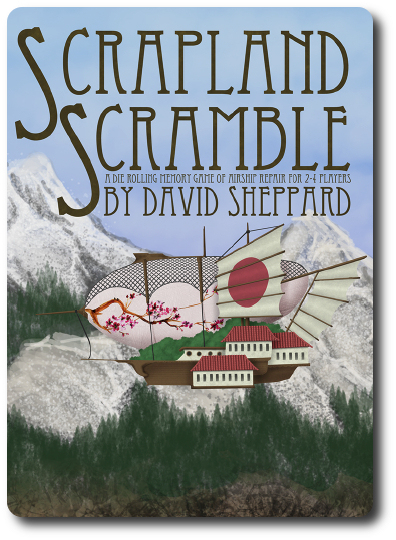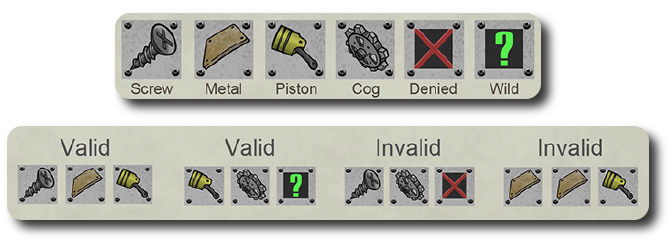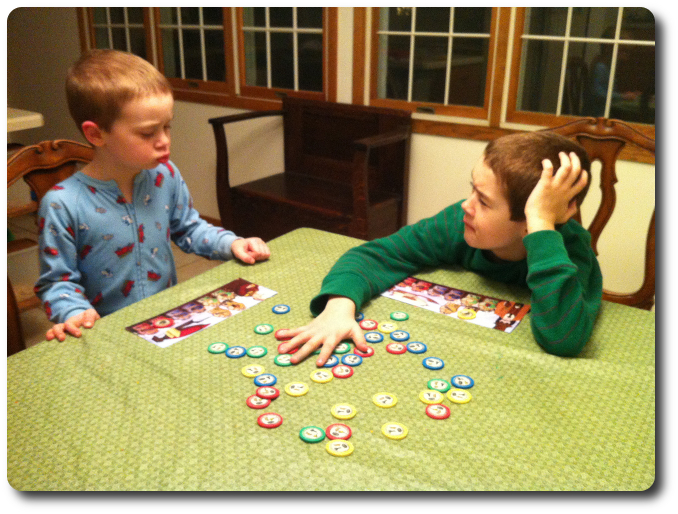
The Basics:
- For ages 5 and up (publisher suggests 18+)
- For 2 to 4 players
- Approximately 45 minutes to complete
Geek Skills:
- Counting & Math
- Logical & Critical Decision Making
- Reading
- Memorization & Pattern/Color Matching
Learning Curve:
- Child – Easy
- Adult – Easy
Theme & Narrative:
- Quickly find the missing parts you need to fix your airship before your opponents leave you behind!
Endorsements:
- Gamer Geek rejected!
- Parent Geek approved!
- Child Geek approved!
Overview
The airship marked a turning point in society. Now the skies were open to exploration, commerce, and illegal activity. The clouds became hiding places for Speakeasies, black market dealers, and much more unsavory activities. As a result, the Sky Patrol was created to help keep the peace. In an attempt to avoid being arrested during a recent “job”, you have accidentally wrecked your airship along with a few unlucky others. Fix your airship as quickly as possible to avoid certain incarceration!
Scrapland Scramble, an independent and self-published card game by David Sheppard, is comprised of 12 custom six-sided dice (3 dice each in the colors blue, white, black, and red), 48 tokens (12 tokens each in the colors red, green, blue, and yellow), and 4 player mats. The players mats are made of thick cardstock and reinforce the game’s Steampunk theme with nicely done illustrations. The dice and tokens are made of thick and durable plastic. It is also worth noting that this game was a finalist in the Game Crafter’s Steampunk game design challenge.
Surveying the Crash Site
Note: Prior to playing your first game, the game owner will be required to apply stickers to every die and to all 48 tokens. While not difficult, close attention must be given to the process to ensure the right stickers are applied. Failure to do so will result in a “broken game”. It took us about 30 minutes to complete the process of adding the stickers, but we weren’t rushing it, either.
To set up the game, first have each player select a player mat. The player mat represents the player’s airship they will be attempting to rebuild. Other than the illustrations and the name of the airship, each player mat is identical.
Second, take all the tokens and quickly stack them into sets of 12 and by color. Depending on the length of game desired, place 2, 3, or 4 sets of tokens on the table, face-down, in the center of the playing area. More sets equals a longer game. Quickly randomize these tokens by moving them about on the table. All the players can (and should) participate in this set up step, being careful to “mess up” the tokens without sending them off the table or shooting across the room.
Third, give to each player a set of 3 dice of the same color.
That’s it for game set up! Time to quickly rebuild your airship and escape before the Sky Patrol arrives!
Scrambling for Scrap
The game is played in rounds with each round broken down into 3 sequential steps. These steps are summarized here.
Step 1: Recollection
Each player takes their three dice and rolls them. The players are attempting to roll a set of 3 different components (screws, metal, pistons, and cogs, respectively). The die also has a wild value (represented as a question mark and can represent any component) and a denied value (represented as a black box with a red “X”). Each time a player rolls their die, they must “lock” one of them (the same game mechanism is used in Zombie Dice, Martian Dice, Trophy Buck, and Farkle). Locked dice cannot be re-rolled. Players cannot roll more than 3 times, but are welcome to stop at anytime during this step if they have rolled a set of 3 different components.

Step 2: Search the Scrapland
This step is only available to those players who successfully rolled a set of 3 different components (with or without the use of wild values). Players who cannot participate in this step are not out of the game, however. On the contrary, they should pay very close attention to what the other players are doing and what tokens they reveal.
For those who did successfully roll a set of 3 different components (or any number of components and wild values), they now get to look at a token in the center of the playing area (refered to as the “Scrapland”). The players are welcome to look at any one token that matches the set of components they rolled. The color of the token is not meaningful during this step. For example, if the player rolled a screw, a piston, and a cog, they can only look at a token that has those three components. If the player rolled a wild value, then the player need only match the tokens to whatever components they rolled. In the case of rolling 3 wild values, any token can be selected.
Once the player has identified a token, they pick it up and flip it over so that all the players can see what is on the other side.
Step 3: Rebuild Ship
The Scrapland is filled with junk, both literally and figuratively speaking. There are tokens that are identified as “Useless Junk” and any part found that does not also identify itself as belonging to the player’s airship is useless, too.
If the token revealed is “Useless Junk” or not identified as a part that belongs to the player’s airship, it is placed face-down in the same position it was taken from.
If the token revealed matches the name of the player’s airship, it can be collected and placed on the matching spot on the player’s player mat.
After completing step 3, the next round beings with step 1 noted above.
Abilities
As the players start to rebuild their airships, the machines that keep it aloft (most of the time) start to become operational. Players can use one of their available abilities provided by these machines once per turn during any of 3 steps, where applicable. These abilities are summarized here.
Rudders
This ability allows the player to drag one token, face-down, through the Scraplands. The token dragged need not be one selected this turn.
Cannons
This ability allows the player to flick one token, face-down, into the Scraplands when it is returned.
Compass
This ability allows the player to exchange the position of two face-down tokens in the Scrapland.
Heat System
This ability allows the player to return “Useless Junk” to the Scrapland face-up, making it easier to identify.
Winch
This ability allows the player to stack “Useless Junk” tokens underneath the Winch token instead of returning it to the Scrapland.
Tools
This ability allows the player to remove one token out from underneath their Winch to re-roll any number of dice. The “Useless Junk” token used for this ability is returned to the Scrapland, face-down.
Wheel
This ability allows the player to place their hand on a section of the Scrapland and rotate it (and the tokens underneath) in any direction, but the hand must pivot on its original spot.
Telescope
This ability allows the player to count one denied value (the red “X”) as a wild value instead.
Making a Run For It
The game continues until a player has collected all their available airship parts. This player is the winner and makes a smooth getaway just as the Sky Patrol arrives to arrest the other players. The number of airship parts available is two times the number of token sets used in the game. For example, if 3 sets of tokens were used, there would be 6 parts that belong to each airship.
Game Variant
The game rules provide a quick description of “Children’s Rules”. The game designer observed that Child Geeks were frustrated with the first step of the round (rolling to collect sets). The “Children’s Rules’ suggest that the dice are removed and that players simply select one token per turn to reveal. Using this game variant removes dice from game set up and play, resulting in step 1 always being ignored. Additionally, some of the abilities made available to the players become useless, but the tokens that provide those abilities must still be collected to win the game.
To learn more about Scrapland Scramble and read the full rules, visit the game’s web page on the Game Crafter.
Prediction
Before we jump into the prediction, I want to discuss the publisher’s minimum age recommendation noted on the Game Crafter. At the time of this review, the minimum age is 18-years-old and older for Scrapland Scramble. Most of the time, the recommended age is based on the game components to comply to safety standards. For example, you don’t want to put The Settlers of Catan in front of a toddler out of fear they will eat an entire island and spend the next week in the hospital. The next most common influencer of the game’s minimum age recommendation is the game’s difficulty, but really, there is no such thing as a game that cannot be learned. Some games will take longer for both children and adults to learn simply because there are a lot of rules. But given enough time, focus, and dedication, even the most difficult of games can be taught to the most inexperienced and unskilled of players. The last and most rare influencer of the game’s minimum age recommendation is the game’s theme and narrative. For example, Cards Against Humanity (the raunchiest, most depraved, and humorous game I have ever played) has a listed minimum age of 17-years-old. I personally think that is too young as the game’s subject matter is very adult, making even veteran game players feel ashamed of themselves whilst playing.
Why do I bother to bring this up? Scrapland Scramble unfortunately lists its suggested minimum age to play the game as 18-years-old and older. However, unlike Cards Against Humanity and other “adult only” games, there are no adult themes, no gratuitous illustrations, or thematic elements of sex, drugs, or violence, and the game play is easy enough for a 5-year-old to learn. So why the 18+? The game components, most likely. Small, round, colorful, and tasty looking. I think 18+ is overkill to the extreme and very misleading, however. This is most certainly a family game and I think the age recommendation is an unfortunate mistake I hope the game publisher addresses in the near future.
OK. Moving on…
Scrapland Scramble is a memory game with the opportunity for players to get abilities that can really mess up other players and provide slight advantages. I think the Child Geeks are going to enjoy it, but I’m going to guess the dice are going to be removed from play. The Child Geeks are going to have a difficult enough time as it is trying to remember where tokens are and the added randomness of the dice will most likely be abandoned. I doubt the Parent Geeks will enjoy this game at a peer level, but will enjoy playing it as a family game. The Gamer Geeks are going to turn their nose up to Scrapland Scramble, I guarantee it.
Teaching the game is very straightforward and simple. Roll dice, select a token, keep it or put it back. The first to collect what they need wins the game! I did spend a moment or two on how the abilities that could be used, but only because the players asked. Other than that, no one under the age of 8 had any questions. And so, as I set the game up for my first play with my two oldest little geeks, I asked them their thoughts on Scrapland Scramble so far.
“A new twist on an old memory game. I like it so far.” ~ Liam (age 8)
“I like how I can get special moves to mess up the other players!” ~ Nyhus (age 5)
My 5-year-old is being uncharacteristically aggressive. I wonder if there wasn’t an “incident” earlier in the day between him and his older brother that remains unsettled. Whatever it might be, it’s time to jump into the scrap pile and see if we find this game to a unique treasure or just junk.
Final Word
The Child Geeks enjoyed this game but were frustrated by the dice. Many of the younger Child Geeks felt cheated and started to think that the dice were somehow out to get them. When we removed the dice, all the issues the Child Geeks had with the game magically dissolved. It was enough of a challenge for them to try to remember where the right tokens were and they loved hunting down what they needed. They also used the special abilities very well. A bit too well on one occasion when one of our Child Geeks used the Rudder ability with more strength than required and sent a number of tokens flying off the table. There was much laughter as a result. After several games, all the Child Geeks thought Scrapland Scramble was a fun game and enjoyed it enough to approve it under one condition: the dice should never be used again.

A look of disapproval from his brother before he messes up the Scrapland!
The Parent Geeks, as predicted, didn’t care for the game with their peers. Also as predicted, they love it with the family. Scrapland Scramble proved to be an entertaining, challenging, and casual game that worked perfectly at the family gaming table. The Parent Geeks didn’t care for the dice either, stating that they felt “thrown in” and not the least bit necessary to game play. After a few games with the dice, the Parent Geeks put them aside and never used them again. Because they found Scrapland Scramble to be enjoyable with their family, accessible to their young Child Geeks, and strengthened memory and logical thinking skills, the Parent Geeks gladly approved it.
The Gamer Geeks were not very impressed with this game for three reasons. First, they didn’t care for the fact that you had to roll dice and hope that you randomly rolled the icons you needed to collect a token. In their mind, the dice only served to lengthen the game. This belief was further reinforced when all of the players were locked out for a round and several Gamer Geeks couldn’t collect the token they needed to win because the dice rolls didn’t allow it. Second, once you did roll 3 unique icons, you then had to spend time hunting for a token that matched. Again, it felt like a needless mechanism to lengthen the game. The Gamer Geeks refused to play the game without dice, stating that the “Children’s Rules” that allowed no dice suggested that the game should be played with the dice normally. Third , Scrapland Scramble, at its core, is just a memory game. Yes, the Gamer Geeks appreciated the special abilities to be obtained, but the constant need to hunt blindly for needed tokens seemed long, painful, and not in the slightest bit fun to them. According to one Gamer Geek, “If I was a kid, I would love this game. As an adult, I am looking for a game that challenges my ability to reason and think, not test my patience and memory skills.” This sentiment was shared by the majority of Gamer Geeks we played the game with. Some liked it a bit more than others, but not one single Gamer Geeks suggested it was a game that was made for them.
If I was just a Gamer Geek, I wouldn’t care for Scrapland Scramble in the slightest. As a Parent Geek, I am totally into it. I have played many memory games, for example Taiga and (of course) Memory, that all boil down to remembering where things are before your opponent figures it out. Scrapland Scramble is no different, but with the addition to obtain special abilities the game feels bigger, better, and more “Gamer Geekish”. And yes, I agree with the Gamer Geeks, this is not a gamer’s game. But it is a game a Gamer Geek can more than tolerate when playing with family and children. There are a lot of Child Geek memory games on the market today that are borderline painful to play as an adult, but this is not the case with Scrapland Scramble. I’ve never had a bad game experience with my family and it teaches and reinforces some very important Geek Skills along the way.
In the end, Scrapland Scramble is exactly what it set out to be: a memory game using the Steampunk theme. For those who like memory games, Scrapland Scramble will certainly be enjoyed and this would serve as an excellent “advanced memory” game for Child Geeks who are showing interest in different games. I tip my hat to the game designer for creating a unique memory game with abilities that can be earned, activated, and used to really annoy others. If used correctly, the abilities could mean the difference between victory and a bitter defeat. That is a new twist on a classic memory game I am most pleased to incorporate into my game play and have at my family gaming table.
This game was given to Father Geek as a review copy. Father Geek was not paid, bribed, wined, dined, or threatened in vain hopes of influencing this review. Such is the statuesque and legendary integrity of Father Geek.




Huh. It had honestly never occurred to me to leave the dice out–and for much of the same reason you cited for the gamer geeks. Next time I break it out, I’m going to try it without the dice.